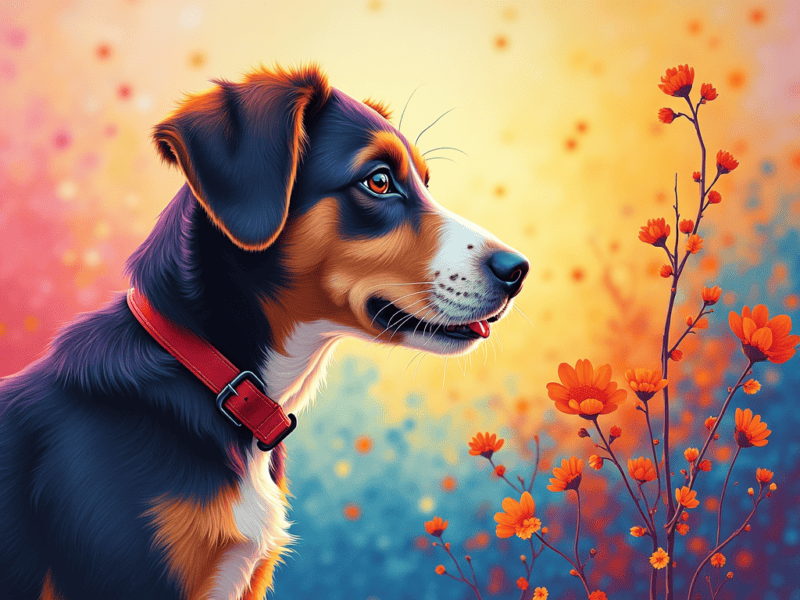If you’ve ever wondered whether your pup’s world is as vibrant as yours, you’re not alone! Let’s dive into how dogs see colors and whether the world is a monochrome movie for them or actually has a pop of hues.
Can Dogs Really See Colors?
Dogs may not see quite as many colors as we humans do but their world is anything but black and white. However, they view a more narrow spectrum of color, but still colorful. Consider their vision as muted color, where some colors are less apparent compared to ours, while others look just perfect. Oh, and they also have much better smell and hearing senses, which compensate more than well for the colors they lose!

Why Humans See Colors Differently
Color vision in humans and dogs depends on photoreceptor cells in the retina. The two types of these cells are rods (for vision in the dark) and cones (for detecting color). Trichromatic vision means that our visual system is based on three types of cones (red, green, and blue) within our eyes. This allows us to observe a wide spectrum of colours like dark reds and bright yellows, and blues.
However, dogs are what we call dichromats which possess two forms of cones (blue and green). This restricts them from differentiating multiple color tones, especially reds and greens, resulting in a color palette akin to various browns or greys.
Canine Colorblindness Types
There are different types of color blindness humans can have but dogs have a form called protanopia. This means they do not have those red cone cells, so they struggle to see reds and greens. They imagine something similar to a person with red-green color blindness seeing the world as blue, yellow, and gray.

But What Colors Can Dogs Actually See?
What’s easy for a dog is seeing the blues and yellows they can see, which makes the green grass and the red toy a little hard to tell apart. The world for them might resemble the following:
- Blue shades (sky and water)
- Yellow colours (sun and some toys)
- Gray colours (anything outside of those colours!)
Although they cannot perceive each color, they can differentiate a few shades of these limited colors. When you are on sale for taking dog toys, vibrant blues and yellows will stay visible higher than reds or greens, which can combine the heritage.
How Can We Be Sure Of The Colors Dogs Perceive?
Psychoanalysts have used a number of assessments to investigate colour conclusions in puppies. For example, they showed dogs colored circles to see if they could tell the difference between them. Dogs recognized blue and yellow dots distinctly, while red and green seemed similar to them. These discoveries, together with anatomical studies of dog eyes, contribute to a picture of their singular colour vision.
Why Dogs See the Way They Do
After all, dogs in the wild evolved for survival. Their ancestors were nocturnal hunters, who had night vision but not the ability to see color. Dogs are much better at seeing in the dark and detecting motion—both of which are important for spotting prey or danger at dawn and dusk—due to a higher concentration of rods in their eyes.
Snakes also have reflective tissues in their eyes, called the tapetum lucidum, which bounces back light to increase progeny in darkness. That is why the eyes shine in the dark and that is why they are good at spotting movement.
How Does a Dog See Compared to Us?
Aside from color, the other major differences are in clarity and field of view. Dogs can be more near-sighted and have an estimated visual acuity of 20/75. This means while they might have a hard time placing you when they see you from a distance, they do a damn good job of noticing movement out of the corners of their eyes. They have a field of vision of nearly 240 degrees to our 180, so the view they have of any movement is much larger.
That eye position might cost them some 3D vision, but it seems a worthy swap given their ability to see in 360 status and low-light situations. Such special characteristics make them good protectors and night investigated dogs.
Wrapping Up
So, while your dog may miss out on some vibrant colors, they’re far from colorblind. Their vision is a blend of yellows, blues, and grays—an adaptation that has served them well for thousands of years. Next time you play fetch, try a yellow or blue toy to keep it visible for your furry friend, and appreciate the fascinating way they see the world. After all, in their eyes, the world is just as rich in sensory wonder, if not more so, thanks to their powerful noses and ears.


